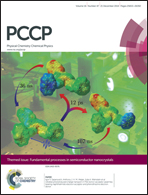Rotationally resolved water dimer spectra in atmospheric air and pure water vapour in the 188–258 GHz range†
Abstract
New experimental results regarding “warm” water dimer spectra under equilibrium conditions are presented. An almost equidistant series of six peaks corresponding to the merged individual lines of the bound dimer with consecutive rotational quantum numbers is studied in the 188–258 GHz frequency range in water vapour over a broad range of pressures and temperatures relevant to the Earth's atmosphere. The series is a continuation of the sequence detected earlier at lower frequencies at room temperature. The signal-to-noise ratio of the observed spectra allowed investigating their evolution, when water vapour was diluted by atmospheric air with partial pressure from 0 up to 540 Torr. Analysis of the obtained spectra permitted determining the dimerization constant as well as the hydrogen bond dissociation energy and the dimer spectral parameters, including the average coefficient of collisional broadening of individual lines by water vapour and air. The manifestation of metastable states of the dimer in the observed spectra is assessed. The contribution of three possible pair states of water molecules to the second virial coefficient is evaluated over the broad range of temperatures. The work supports the significant role of the water dimer in atmospheric absorption and related processes.


 Please wait while we load your content...
Please wait while we load your content...